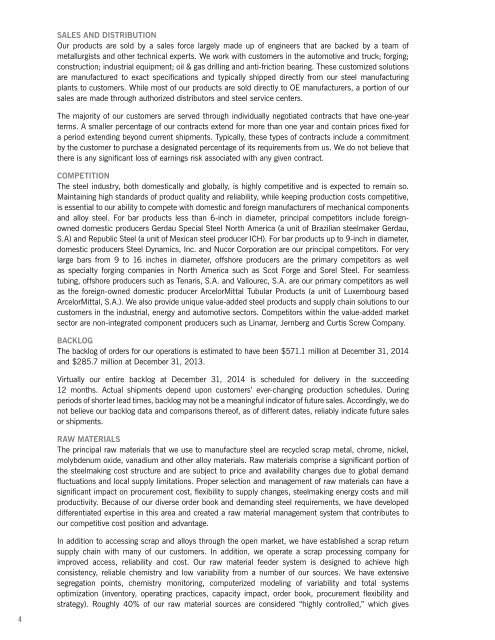TimkenSteel-2014-Annual-Report-FINAL-03112015_v001_d4t4ig
TimkenSteel-2014-Annual-Report-FINAL-03112015_v001_d4t4ig
TimkenSteel-2014-Annual-Report-FINAL-03112015_v001_d4t4ig
Create successful ePaper yourself
Turn your PDF publications into a flip-book with our unique Google optimized e-Paper software.
SALES AND DISTRIBUTION<br />
Our products are sold by a sales force largely made up of engineers that are backed by a team of<br />
metallurgists and other technical experts. We work with customers in the automotive and truck; forging;<br />
construction; industrial equipment; oil & gas drilling and anti-friction bearing. These customized solutions<br />
are manufactured to exact specifications and typically shipped directly from our steel manufacturing<br />
plants to customers. While most of our products are sold directly to OE manufacturers, a portion of our<br />
sales are made through authorized distributors and steel service centers.<br />
The majority of our customers are served through individually negotiated contracts that have one-year<br />
terms. A smaller percentage of our contracts extend for more than one year and contain prices fixed for<br />
a period extending beyond current shipments. Typically, these types of contracts include a commitment<br />
by the customer to purchase a designated percentage of its requirements from us. We do not believe that<br />
there is any significant loss of earnings risk associated with any given contract.<br />
COMPETITION<br />
The steel industry, both domestically and globally, is highly competitive and is expected to remain so.<br />
Maintaining high standards of product quality and reliability, while keeping production costs competitive,<br />
is essential to our ability to compete with domestic and foreign manufacturers of mechanical components<br />
and alloy steel. For bar products less than 6-inch in diameter, principal competitors include foreignowned<br />
domestic producers Gerdau Special Steel North America (a unit of Brazilian steelmaker Gerdau,<br />
S.A) and Republic Steel (a unit of Mexican steel producer ICH). For bar products up to 9-inch in diameter,<br />
domestic producers Steel Dynamics, Inc. and Nucor Corporation are our principal competitors. For very<br />
large bars from 9 to 16 inches in diameter, offshore producers are the primary competitors as well<br />
as specialty forging companies in North America such as Scot Forge and Sorel Steel. For seamless<br />
tubing, offshore producers such as Tenaris, S.A. and Vallourec, S.A. are our primary competitors as well<br />
as the foreign-owned domestic producer ArcelorMittal Tubular Products (a unit of Luxembourg based<br />
ArcelorMittal, S.A.). We also provide unique value-added steel products and supply chain solutions to our<br />
customers in the industrial, energy and automotive sectors. Competitors within the value-added market<br />
sector are non-integrated component producers such as Linamar, Jernberg and Curtis Screw Company.<br />
BACKLOG<br />
The backlog of orders for our operations is estimated to have been $571.1 million at December 31, <strong>2014</strong><br />
and $285.7 million at December 31, 2013.<br />
Virtually our entire backlog at December 31, <strong>2014</strong> is scheduled for delivery in the succeeding<br />
12 months. Actual shipments depend upon customers’ ever-changing production schedules. During<br />
periods of shorter lead times, backlog may not be a meaningful indicator of future sales. Accordingly, we do<br />
not believe our backlog data and comparisons thereof, as of different dates, reliably indicate future sales<br />
or shipments.<br />
RAW MATERIALS<br />
The principal raw materials that we use to manufacture steel are recycled scrap metal, chrome, nickel,<br />
molybdenum oxide, vanadium and other alloy materials. Raw materials comprise a significant portion of<br />
the steelmaking cost structure and are subject to price and availability changes due to global demand<br />
fluctuations and local supply limitations. Proper selection and management of raw materials can have a<br />
significant impact on procurement cost, flexibility to supply changes, steelmaking energy costs and mill<br />
productivity. Because of our diverse order book and demanding steel requirements, we have developed<br />
differentiated expertise in this area and created a raw material management system that contributes to<br />
our competitive cost position and advantage.<br />
In addition to accessing scrap and alloys through the open market, we have established a scrap return<br />
supply chain with many of our customers. In addition, we operate a scrap processing company for<br />
improved access, reliability and cost. Our raw material feeder system is designed to achieve high<br />
consistency, reliable chemistry and low variability from a number of our sources. We have extensive<br />
segregation points, chemistry monitoring, computerized modeling of variability and total systems<br />
optimization (inventory, operating practices, capacity impact, order book, procurement flexibility and<br />
strategy). Roughly 40% of our raw material sources are considered “highly controlled,” which gives<br />
4


